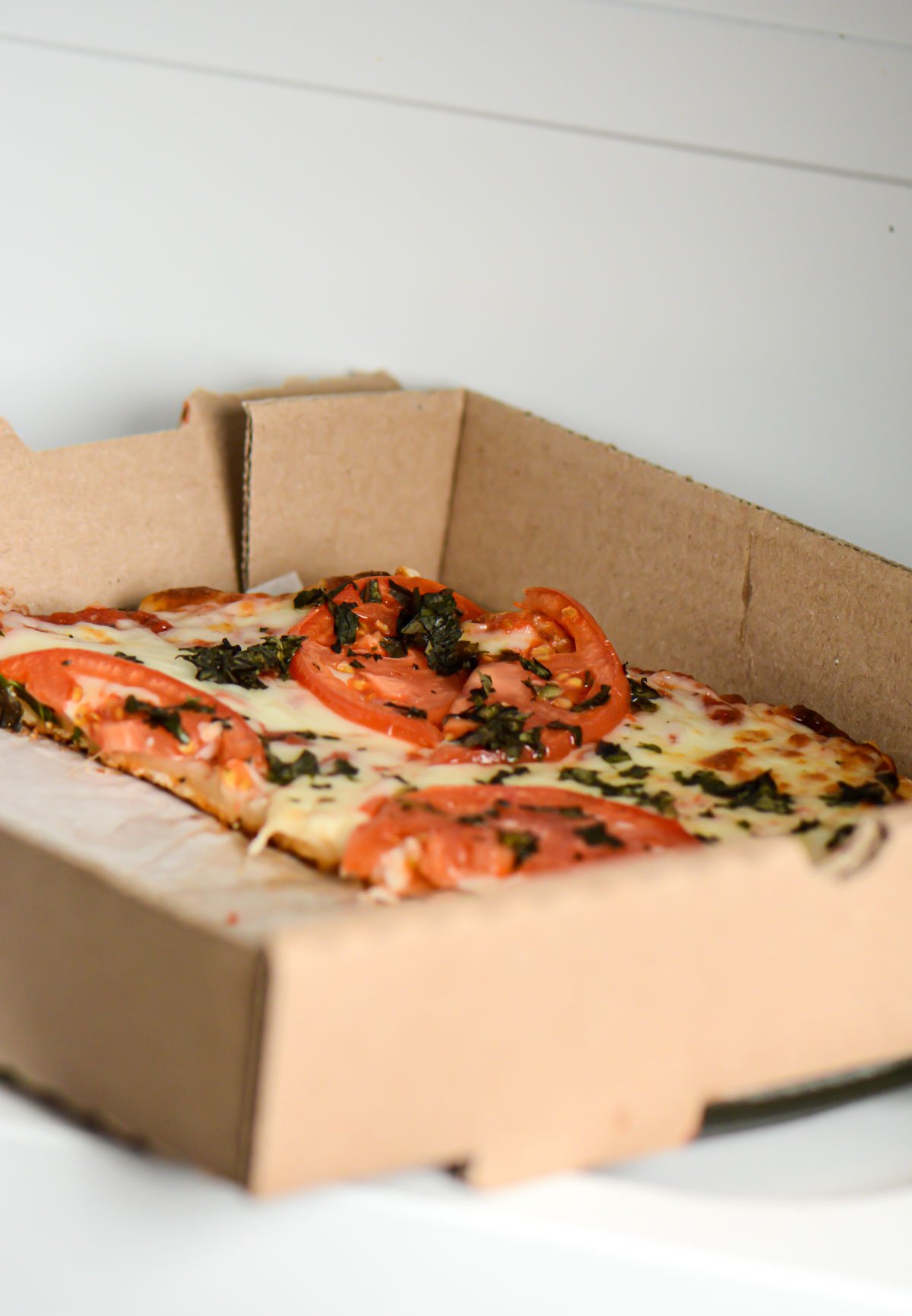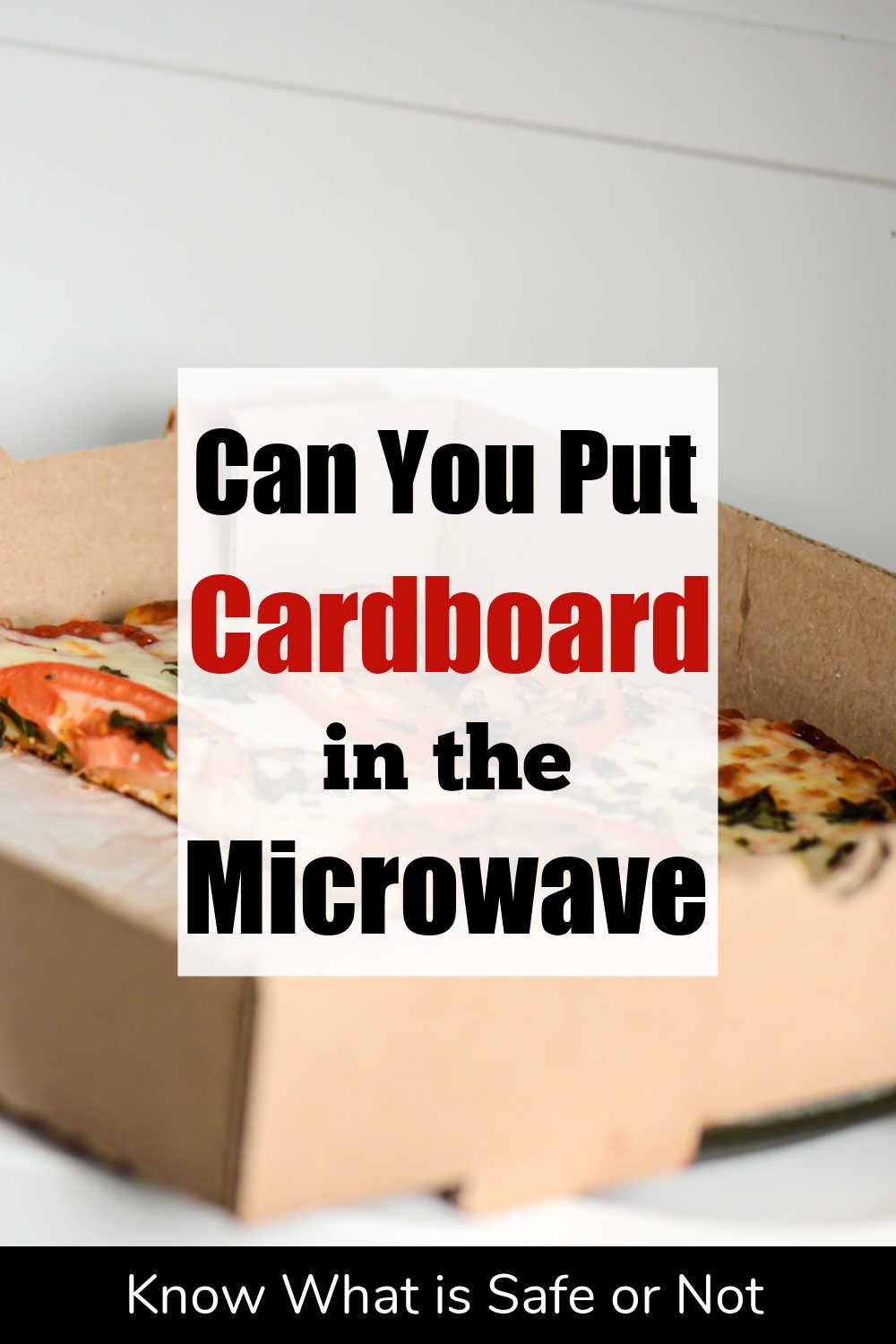We’ve all brought home leftovers in little cardboard containers and wondered “Can you put cardboard in the microwave?” for lunch tomorrow. Here’s all the do’s and don’t’s for putting cardboard in the microwave oven.

Microwaves have surely made life a lot easier; a few seconds or minutes is all it takes to heat up or even cook some meals! But with the great convenience that microwaves offer, comes a fair share of confusion when reheating leftovers in little cardboard containers.
This is mainly related to the types of materials that you can safely microwave without ruining the appliance, the container, the food, or -more importantly- affecting your health.
From styrofoam and aluminum to glass, ceramic and plastic, people just keep wondering about the safety of microwaving different materials – and rightfully so.
The easiest thing to do is to look for a microwave-safe label on the container.
Can You Put Cardboard in the Microwave?
Yes, you can put pure cardboard food containers (with no plastic coatings) in the microwave as long as it has food or liquid and does not contain metal, glue, certain types of ink and dyes, wax coating, or plastic. You should also maintain close supervision while the cardboard is inside the microwave and avoid overheating it / seeing sparks from hidden metal.
Is It Safe?
The level of safety of microwaving cardboard depends on the type of cardboard container and how you plan on microwaving it. Let’s take a look at safe vs unsafe scenarios:
When Is It Safe?
Microwave-safe cardboard (pure cellulose made from wood fiber) will be labeled microwave-safe and or already contains food, water or coffee. Yes, those take away cardboard coffee cups are safe to re-heat in the microwave when you didn’t drink it fast enough.
If it isn’t specifically listed, the easiest choice is to transfer the food or drink to a cup or bowl before heating.
Ready for a little bit of a science lesson on how microwaves work?
The basic concept of how a microwave’s operation is that it emits electromagnetic waves of a specific wavelength. These radio waves are then absorbed by the moisture content in the food or drink, leading to a build-up of energy in water molecules.
These hyperactive molecules will then start to move and interact with one another, producing heat that warms up your food or drink.
The typical moisture content of packaging cardboard is around 8%, which is why it can dry up pretty quickly inside a microwave.
However, if you put food or drink inside the cardboard, most of the microwaves will get absorbed by the item with the higher moisture content -the food or drink-, ensuring that the moisture content in the cardboard doesn’t drop to hazardous levels.
As such, reheating food or drink in cardboard containers is generally safe. On the other hand, cooking or boiling in cardboard should be avoided.

When Is It Unsafe?
Here’s when microwaving cardboard containers becomes a safety hazard so take the following safety precautions and proceed with caution:
- If it’s empty — as mentioned above, the typical moisture content in cardboard is about 8%. This is quite low and can deplete quickly inside a microwave, leaving the combustible material of the cardboard vulnerable to increased stimulation – possibly sparking a fire. To be fair, I have never seen that happen, but I don’t see a need to microwave cardboard without any food.
- If it takes too long — overheating cardboard can cause the cardboard fibers to spontaneously combust as a result of over-drying. Without any moisture content left, the chances of the flammability of cardboard to come through become higher.
- If it contains one of the following:
- Metal — some cardboard takeout container use traces of metal to seal up their seams (for example, aluminum foil). In such cases, never microwave the container as metals can damage the appliance and potentially cause a fire hazard. If you see flames, shut off the device immediately!
- Glue — if the cardboard container has glue, it’s best to avoid microwaving it. Not only does heating the glue produces toxic fumes, but also its melted form can mix into your food. Blech!
- Ink and dye — unless the cardboard features microwave-safe ink or dye (it should be labeled on the container), avoid microwaving it. Some types of ink or dye produce toxic gasses and can release harmful chemicals into your food or drink.
- Wax or plastic — sometimes, cardboard containers are coated with a shiny layer of wax or plastic to preserve them and make them stronger. Unless the label says it’s safe, never microwave these materials as they can melt and deposit chemicals into your food or drink.
Easy to Remember: If your “to-go” boxes from restaurants are cardboard, it will be fine to reheat using them. Make sure to remove any foil liners first or metal handles from Chinese takeout containers. Opt for a microwave-safe dish in its place.
Does Cardboard Catch Fire in the Microwave?
It’s possible for cardboard to catch fire when you put it in the microwave in two main cases:
- If the cardboard take-out container is empty, its moisture content can deplete quickly upon heating inside a microwave, leaving the combustible material of the cardboard prone to increased friction and stimulation.
- If you leave it in the microwave for too long, overheating cardboard with a super high temperature can cause over drying, which can lead its fibers to spontaneously combust. Without moisture content, the flammability of cardboard rises significantly.
How Long Can You Microwave Cardboard?
Since overheating can be a serious hazard when it comes to microwaving cardboard, you should keep the microwaving time below two continuous minutes.
If the food on the cardboard still needs heating, run the microwave in 20 or 30-second intervals with one minute of rest between each heating process round.
Select a low power setting as to not overheat is another great option.
Tips and Tricks
Microwave cardboard box tips to use as safely as possible when microwave paper plates aren’t available for use:
- Check the label on the cardboard container to make sure it’s microwave-safe.
- Check for a shiny layer over the board. This means it’s coated in wax or plastic and shouldn’t be microwaved.
- Never microwave food in cardboard for more than 2 minutes. If you need to reheat longer, use a ceramic dish.
- If there’s any wrapping or foil in the cardboard container, be sure to remove it.
- Never microwave cardboard when on its own.
FAQs
Yes, as long as its label says it’s microwave-safe and it doesn’t contain metals, plastic, wax, or glue.
Yes, as long as it doesn’t contain metals, plastic, glue, or wax.
Generally speaking, McDonald’s cardboard boxes don’t contain metals, plastic, wax, or glue, and use microwave-safe inks or dyes. As such, they’re safe to microwave.
Most cardboard pizza boxes contain no metals, plastic, wax, or glue, so they should be safe to microwave.
Look on the bottom of the container. If it says CPET #1, it is microwave safe.
Wrap Up
So, can you put cardboard in the microwave? The answer is yes but with a few precautions.
Don’t microwave cardboard without food in it or if it contains metal, glue, certain types of ink and dyes, wax, or plastic or plastic bags. Also, you should keep close supervision and avoid overheating.
Related Articles
Hi!
Ginny Collins is a passionate foodie and recipe creator of Savor and Savvy and Kitchenlaughter. Indoors she focuses on easy, quick recipes for busy families and kitchen basics. Outdoors, she focuses on backyard grilling and smoking to bring family and friends together. She is a lifelong learner who is always taking cooking classes on her travels overseas and stateside. Her work has been featured on MSN, Parade, Fox News, Yahoo, Cosmopolitan, Elle, and many local news outlets. She lives in Florida where you will find her outside on the water in her kayak, riding her bike on trails, and planning her next overseas adventure.









Leave a Reply